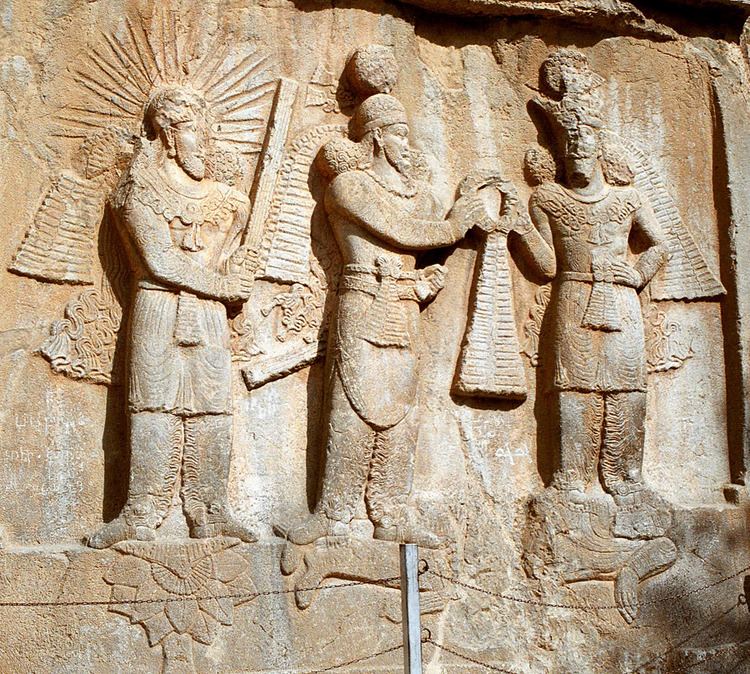Location Mesopotamia, Iraq | ||
 | ||
120,000
95,000 Romans
25,000 Armenians
+1,000 ships Unknown, but presumed to be numerically inferior to the Romans Heavy Moderate
(by modern estimations) Similar Roman–Parthian War of 161–166, Galatian War, Anastasian War, Roman–Persian Wars, Siege of Amida | ||
Julian's Persian War, or the Perso-Roman War of 363, was the last undertaking of the Roman emperor Julian, begun in March 363. It was an aggressive war against the Persian Empire ruled by the Sassanian king Shapur II. Shapur is believed to have expected an invasion by way of the Tigris valley. Julian sent a detachment to join with his ally Arshak II of Armenia and take the Tigris route. Meanwhile, with his main army he advanced rapidly down the Euphrates valley, meeting only scattered opposition, and reached the walls of the Persian capital Ctesiphon where he met and defeated the Persian army at the Battle of Ctesiphon (363). Unable to take the city, and with a faltering plan of campaign, He was misled by Persian spies into burning his fleet and taking a disadvantageous route of retreat in which his army was constantly harassed and his progress crawled to a halt.
Contents
In one of the skirmishes Julian was wounded and later died of his wounds leaving his successor along with his army trapped in Persian territory. The leaderless Roman army chose Jovian as Julian's successor. The new emperor, in light of the "crushing military defeat" the Romans had suffered, was left no option but to agree to humiliating terms in order to save the remnants of his army, and himself, from complete annihilation. The ignominious treaty of 363 transferred to Persian rule the major cities and fortresses of Nisibis and Singara, and renounced the alliance with Armenia, giving Shapur de facto authority to invade and annex Arsacid Armenia as a result. Thus Arsaces II of Armenia was left without any military or diplomatic support. He was captured and imprisoned by Shapur in 368; he committed suicide in 369 or 370 whilst in Persian captivity.
Aims and preparations
According to contemporary Roman sources Julian's aim was to punish the Persians for their recent invasion of Rome's eastern provinces; for this reason he refused Shapur's immediate offer of negotiations. Among the leaders of the expedition was Hormizd, a brother of Shapur II, who had fled from the Persian Empire forty years earlier and had been welcomed by the then Roman emperor Constantine I. Julian is said to have intended to place Hormizd on the Persian throne in place of Shapur. A devout believer in the old Roman religion, Julian asked several major oracles about the outcome of his expedition.
The philosopher Sallustius, a friend of Julian, wrote advising him to abandon his plan, and numerous adverse omens were reported; at the urging of other advisers he went ahead. He instructed Arshak II of Armenia to prepare a large army, but without revealing its purpose; he sent Lucillianus to Samosata in the upper Euphrates valley to build a fleet of river ships. These preparations are thought by scholars to have suggested to Shapur that an invasion from the north, by way of the Tigris valley, was Julian's plan.
The advance
Julian had wintered at Antioch in Roman Syria. On 5 March 363 he set out north-west with his army by way of Aleppo and Manbij, where fifty soldiers were killed in the collapse of a portico while they were marching under it. The whole army mustered there, crossed the middle Euphrates and proceeded to Harran, known to the Romans as Carrhae, site of the famous battle in which the Roman general Crassus was defeated and killed in 53 BC. "From there two different royal highways lead to Persia," writes the eye-witness Ammianus Marcellinus: "the one on the left through Adiabene and across the Tigris; the one on the right through Assyria and across the Euphrates." Julian made use of both. He sent a detachment (numbering 30 000 according to Ammianus but only 18 000 according to Zosimus) under Procopius and Sebastianus towards the Tigris where they were to join Arshak and his Armenian army. They were then to attack the Persians from the north.
Julian himself, with the larger part of his army (which numbered 65,000 although whether that was before or after Procopius' departure is unclear) turned south towards the lower Euphrates, reaching Callinicum (al-Raqqah) on 27 March and meeting the fleet under the command of Lucillianus. There he was met by leaders of the "Saraceni" (Arab nomads), who offered Julian a gold crown. He refused to pay the traditional tribute in return. The army followed the Euphrates downstream to Circesium (the border city) and crossed the river Aboras (Khabur) with the help of a pontoon bridge assembled for the purpose.
